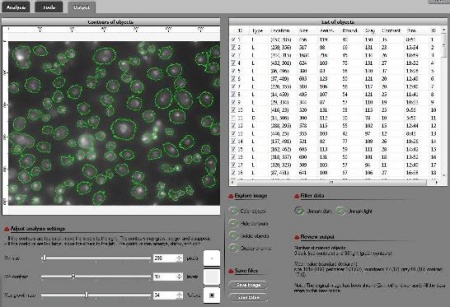Computer Vision Primer: beginner's guide to image analysis, data analysis, related mathematics (calculus, topology, linear algebra), image analysis software, and applications in sciences and engineering.
Pixcavator help
From Computer Vision Primer
Pixcavator is an image analyzer for scientists and researchers. The software captures objects in the image by means of contours (outlines) and produces an Excel spreadsheet with those objects locations and measurements.
To get started:
- see the screenshots.
- watch a video demo (100 sec).
Contents |
Three stages of analysis
The image analysis goes through three main stages:
- Stage 1: automatic. The software creates a data structure that contains complete information about all possible segmentations of the image.
- Stage 2: semi-automatic. The user moves sliders to instantly change objects’ boundaries and choose the best segmentation. The output data is also instantly updated.
- Stage 3: manual. The user excludes noise and irrelevant details from the analysis by clicking on them.
The tabs
For more information about Pixcavator's tabs continue to one of the links below:
- Analysis tab allows the user to load the image and start the analyze.
- Tools tab allows the user to manipulate the image using common image processing tools and special effects
- Output tab allows the user to view, explore and save the output data and the updated image.
Technical details
The current version is 5.1.
- Pixcavator's system requirements
- Installing Pixcavator
- Pixcavator's user's license
- Pixcavator technical support
Note: The user's guide and the license agreement are provided with the program; they are to be found in the "Pixcavator" folder on your hard disk.
Further links
If you need learn more about our software, this site provides dozens of articles. You can start with these:
- How to use it - screenshots
- Why it works - methods and math
- How it has been used - numerous examples from industry and academia
- Customization - more examples
- How well it works - testing Pixcavator
- Who has used it - recent customers
- How to get it - pricing etc
- What else is out there - comparison to related projects, e.g., ImageJ
- FAQ
You can access these pages from the software itself if you have internet access. The links are in the "Help" menu (top right).
Digital discoveries
- Casinos Not On Gamstop
- Non Gamstop Casinos
- Casino Not On Gamstop
- Casino Not On Gamstop
- Non Gamstop Casinos UK
- Casino Sites Not On Gamstop
- Siti Non Aams
- Casino Online Non Aams
- Non Gamstop Casinos UK
- UK Casino Not On Gamstop
- Non Gamstop Casino UK
- UK Casinos Not On Gamstop
- UK Casino Not On Gamstop
- Non Gamstop Casino UK
- Non Gamstop Casinos
- Non Gamstop Casino Sites UK
- Best Non Gamstop Casinos
- Casino Sites Not On Gamstop
- Casino En Ligne Fiable
- UK Online Casinos Not On Gamstop
- Online Betting Sites UK
- Meilleur Site Casino En Ligne
- Migliori Casino Non Aams
- Best Non Gamstop Casino
- Crypto Casinos
- Casino En Ligne Belgique Liste
- Meilleur Site Casino En Ligne Belgique
- Bookmaker Non Aams
- онлайн казино с хорошей отдачей
- スマホ カジノ 稼ぐ
- Trang Web Cá độ Bóng đá Của Việt Nam

